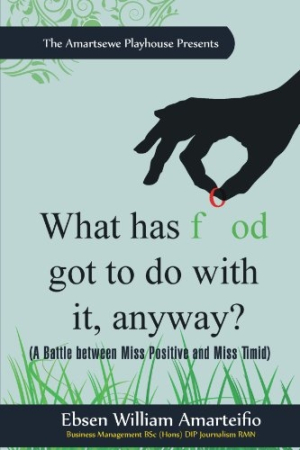What Has Food Got to Do with It, Anyway?
(A Battle between Miss Positive and Miss Timid)
Parents of a young person with an eating disorder often don’t know what they can do to help, if hospitalization is the best choice, or how to keep their child from relapsing after treatment.
Ebsen William Amarteifio, a registered mental-health nurse who has cared for people with eating disorders for more than a dozen years, addresses such challenges in What Has Food Got to Do with It, Anyway? (A Battle between Miss Positive and Miss Timid). Unlike other titles on the subject, this book includes narratives, poems, plays, case studies, and observations based on people who have been in the author’s care.
The book’s opening focuses on a girl in treatment for an eating disorder, giving voice to her struggles via an internal dialogue: “Miss Negative” says things like, “we were making ourselves fat and bloated,” while “Miss Positive” attempts to regain control by explaining that her eating disorder wasn’t really about food, but a way to deal with the pressure her parents put on her to excel academically.
Amarteifio’s premise is that there is always an underlying problem that has caused the patient to restrict food, forcibly vomit, or practice other disordered behaviors. “Factors that are attributed to the condition known as ‘eating disorders’ include parental pressure, family problems, unhealthy sibling rivalry, and emotional and sexual abuse,” he writes. The behaviors exhibited by an anorexic patient, or those with other eating disorders, are complex, sometimes baffling, and always difficult to deal with.
The author does include different perspectives, such as those of anorexic boys and adults with eating disorders. But the book features so many formats and points of view, the book’s target audience is not clear. Is it meant to help parents understand what an anorexic child is going through? Or to give children hope that they can get better?
Neither the title of the book, which references the first play, nor the cover design, which shows grass and a hand picking the letter “o” out of the word food, do not help readers understand what the book is or who it is meant for. The stories are interesting but the shifting viewpoints and formats leave the reader feeling as disjointed as the presentation, without reaching any deeper understanding about the problem of eating disorders or how they can be healed.
While the author doesn’t present information that can’t be found elsewhere, he does offer a bit of hope that eating disorders can be addressed. What Has Food Got to Do with It, Anyway? is a quick read that may help parents and other family members to understand a little bit of what is going on in the mind of the patient. Even though the accounts presented by Amarteifio are fictionalized, they demonstrate that there are ways to survive eating disorders.
Reviewed by
Sarah White
Disclosure: This article is not an endorsement, but a review. The publisher of this book provided free copies of the book and paid a small fee to have their book reviewed by a professional reviewer. Foreword Reviews and Clarion Reviews make no guarantee that the publisher will receive a positive review. Foreword Magazine, Inc. is disclosing this in accordance with the Federal Trade Commission’s 16 CFR, Part 255.

